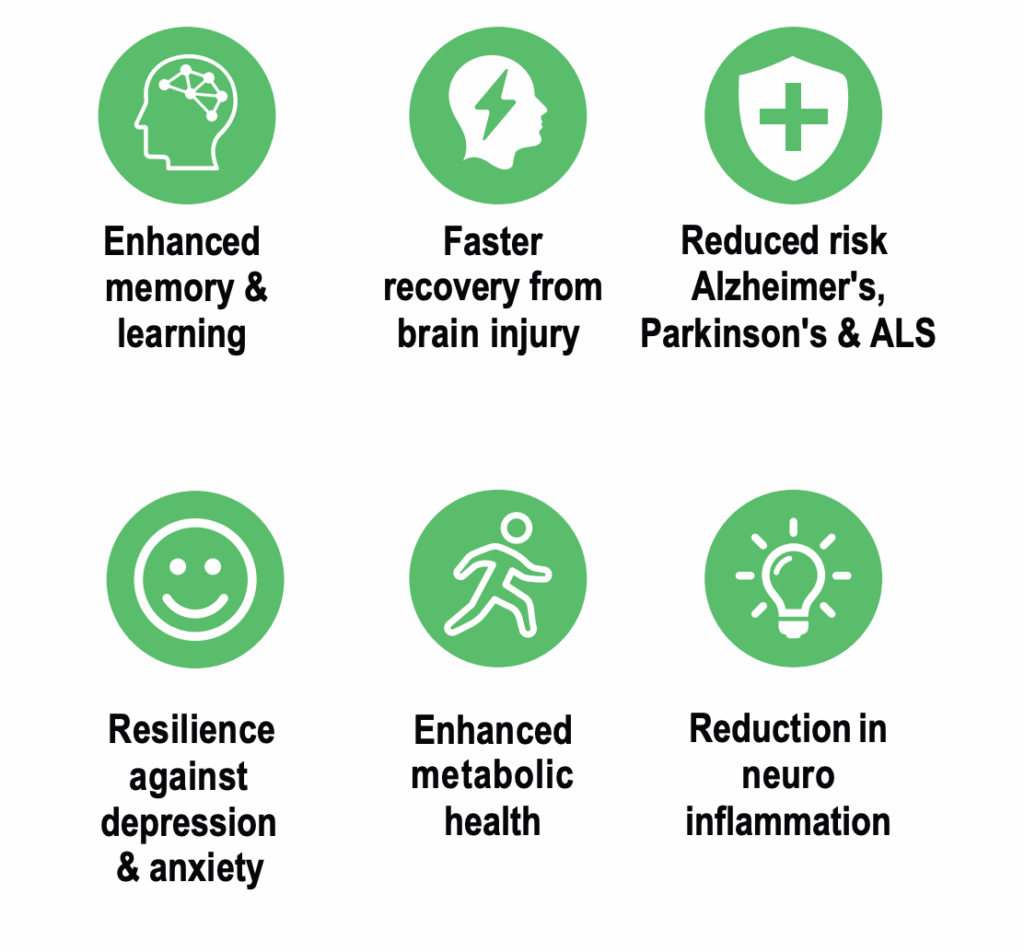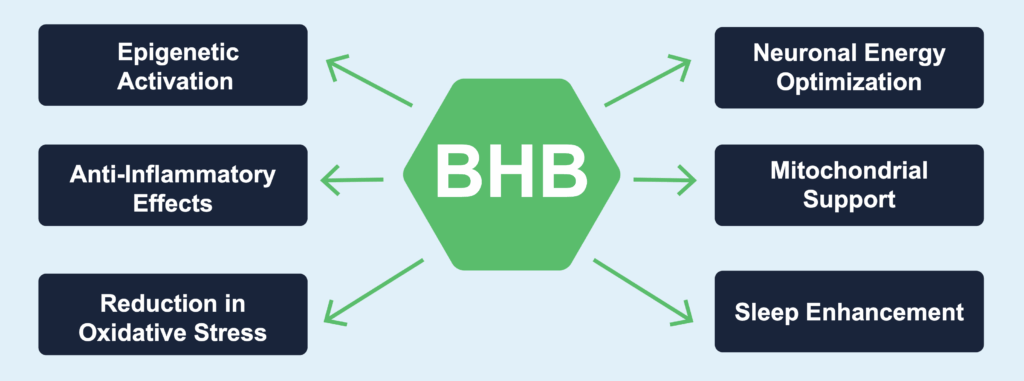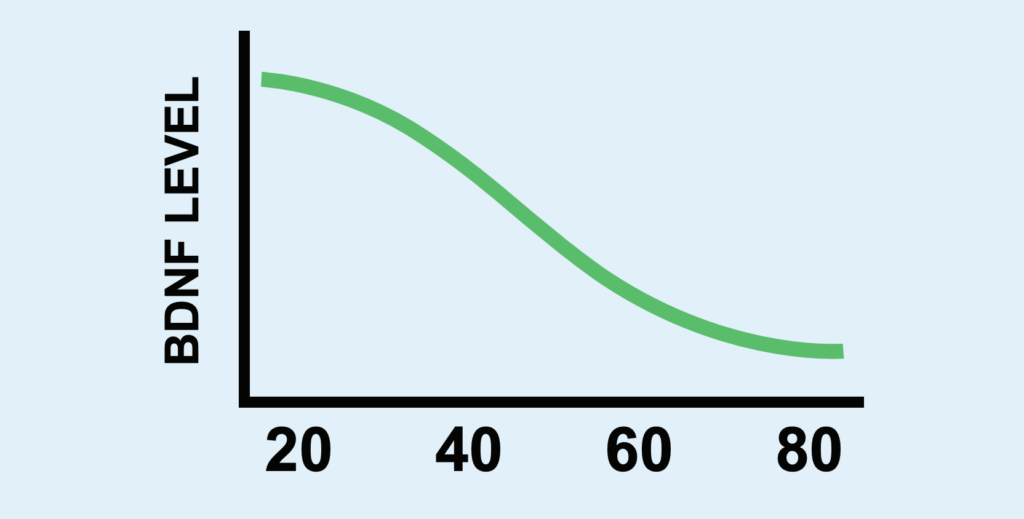THE WORLD’S MOST POWERFUL SCIENCE BACKED INGREDIENT.
BDNF (Brain-Derived Neurotrophic Factor) is one of the most powerful molecules in the human body. It is the master growth factor that controls brain development, repair, resilience, and performance. High levels of BDNF are associated with:
- Enhanced memory and learning
- Improved mood and emotional balance
- Faster recovery from brain injuries
- Protection from neurodegenerative diseases (Alzheimer’s, Parkinson’s, ALS)
- Increased metabolic flexibility
- Reduced inflammation and oxidative stress
- Prevention of age-related cognitive decline
The BDNF Crisis: A Modern Epidemic
- After age 40, BDNF levels naturally decline.
- Chronic stress, poor diet, lack of exercise, inflammation, and poor sleep all accelerate this drop.
- Low BDNF levels are now strongly linked to the global rise in dementia, mood disorders, obesity, and brain aging.
BHB: The Most Powerful Natural BDNF Activator
BHB (Beta-Hydroxybutyrate) is the primary and most powerful ketone body.
Multiple published studies have shown BHB activates BDNF through six distinct and complementary biological mechanisms:
1. Epigenetic Activation via HDAC Inhibition
- BHB inhibits Class I histone deacetylases (HDACs), unlocking gene transcription for BDNF.
- This is the most direct known dietary method to increase BDNF at the genetic level.
2. Powerful Anti-Inflammatory Effect
- BHB suppresses key inflammatory cytokines (IL-1β, IL-6, TNF-alpha).
- Chronic inflammation suppresses BDNF. BHB reverses this, allowing BDNF expression to rise.
3. Oxidative Stress Reduction
- BHB scavenges damaging reactive oxygen species (ROS).
- Reducing oxidative stress protects neurons and allows optimal BDNF production.
4. Neuronal Energy Optimization
- BHB provides a clean, efficient fuel source for brain mitochondria.
- Supports ATP production needed for BDNF-driven neuroplasticity.
5. Sleep Enhancement
- BHB supports deep slow-wave sleep cycles, directly linked to BDNF upregulation.
- Better sleep = higher natural BDNF output.
6. Synergy with Exercise (HIIT)
- HIIT dramatically increases BDNF.
- BHB supplementation amplifies this effect by enhancing recovery, reducing post-exercise inflammation, and maintaining elevated BDNF for longer.
BHB + BDNF: The Neuroprotection Stack
Because BHB impacts BDNF through multiple pathways simultaneously, it may offer unmatched neuroprotection and cognitive enhancement. Studies suggest BHB may:
- Improve working memory and learning speed
- Reduce anxiety and depression symptoms
- Lower risk of Alzheimer’s disease by improving amyloid clearance
- Protect neurons from age-related degeneration
- Improve insulin sensitivity and metabolic brain health
- Support mood stability and emotional resilience
- Increase longevity of brain function well into advanced age
Clinical Literature Supporting BHB’s BDNF Activation
- Sleiman SF et al. BHB activates BDNF expression via class I HDAC inhibition. Nature Communications, 2016.
- Rahman M et al. BHB as a neuroprotective metabolite in oxidative stress. J Cell Biochem, 2014.
- Kanoski SE et al. BDNF, obesity, and cognition. Physiol Behav, 2011.
- Gomez-Pinilla F et al. Exercise, BDNF and cognitive function. Nat Rev Neurosci, 2008.
- Newman JC, Verdin E. Ketone bodies as signaling metabolites. Cell Metabolism, 2014.
The Bottom Line
“BHB is one of the most effective, scientifically-validated compounds for naturally increasing BDNF. No other nutrient activates this many BDNF pathways simultaneously.”
For individuals concerned with cognitive health, mood stability, neuroprotection, and brain longevity, BHB offers a uniquely powerful solution.
BHB fuels the brain. BDNF builds the brain. Together, they unlock your brain’s full potential.
Why BDNF Matters?

HOW BHB INCREASES BDNF

THE CRISIS: BDNF DECLINES WITH AGE, STRESS, AND INFLAMMATION

- BDNF levels naturally fall after age 40
- Obesity, high sugar diets, poor sleep and chronic inflammation reduce BDNF
- Modern lifestyle leads to epidemic levels of low BDNF, cognitive decline, and mood disorders
*These statements have not been evaluated by the Food and Drug Administration. This product is not intended to diagnose, treat, cure, or prevent any disease.




